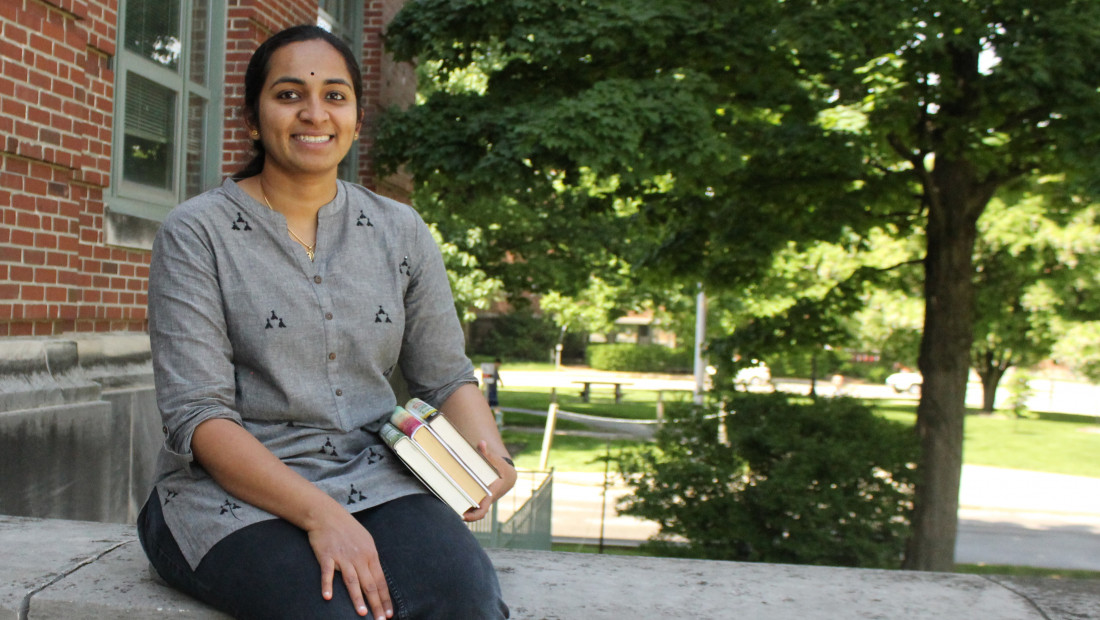
Doctoral student Nithya Sivashankar did not mince words in her application for an Ohio State Presidential Fellowship.
“Ours is a world where a child is being forcibly displaced every four seconds due to war or persecution,” she wrote, quoting the United Nations High Commissioner for Refugees.
“The dramatic rise in the number of people around the world facing displacement crises necessitates efforts to enlighten children and educate teachers about the experiences of refugees, displaced persons and asylum seekers."
Now with the coveted Ohio State award, Sivashankar, a doctoral candidate in the Literature for Children and Young Adults program, has launched her dissertation study. Her goal: to help educators, parents, librarians and other book professionals critically evaluate picture books about immigration and refugees. Adults can then engage children ages 10 and younger in mindful reading.
“If an adult understands the context (of the story) and the strategies used by the author and illustrator to sway the reader’s feelings, helping them either bond with or distance from characters in the story, they would be able to talk with a child about the intent of the story and the varied ways of interpreting it,” she said.
Alan Hirvela, professor and vice chair of graduate studies in the Department of Teaching and Learning, wrote in his letter of support that Sivashankar’s research addresses an extraordinarily important research population: individuals who have become refugees from their countries and are grappling with the challenges of displacement.
“This is dissertation research that truly matters,” he said.
“She will help publishers create more thoughtful books,” wrote Sarah Park Dahlen, professor at St. Catherine University, Minnesota, and co-founder and co-editor of the journal Research on Diversity in Youth Literature, “and inform educators and caregivers on how to use books as tools to talk with young people about difficult topics such as war, genocide and displacement.”
Creating a framework to understand picture books
Sivashankar’s dissertation will describe a framework she created that puts three types of theories about narrative in conversation with each other:
- Rhetorical narratology theory, which views story narrative as a medium for authors and illustrators to communicate with their audiences
- Empathy theory, which offers ways to understand authors’ and illustrators’ use of literary and visual devices to sway the feelings of the reader
- Spectator theory, which helps with understanding choices by authors and illustrators about how to portray a sufferer in news text and visuals
Her unique contribution: She will apply the theories for the first time to children’s picture books ― specifically picture books about Middle Eastern and South Asian immigrants and refugees.
Her work also breaks new ground because, despite the growth of this genre, little research has been done about the portrayal of the refugee experience in children’s books.
Sivashankar gave two examples of devices used by authors or illustrators to sway readers’ feelings.
An author might write the narrative in the first person, but the visuals are often not from the first-person perspective.
“This creates enough distance between the child reading the book and the character so the child can empathize but not feel traumatized by what is happening in the scenes,” she said.
As another example, she cites a book about a granduncle telling the story to his grandnephew about his family’s displacement during the Partition of India and Pakistan. The splitting of the subcontinent into two is depicted using the visual of a teacup with a single, long crack.
“This device mitigates the consequences of the conflict and presents it to the young reader in a more palatable and understandable way,” she said.
Literary analysis and teaching uniquely combined
Sivashankar came to the college’s program in Literature for Children and Young Adults in a roundabout way. She studied biotechnology as an undergraduate but simultaneously worked as a freelance journalist for the Indian newspaper, The Hindu.
After graduating, she worked as a reporter and sub-editor for two newspapers in India. Thanks to her lifelong interest in children’s books, she particularly enjoyed assignments that required interviewing publishers and authors of such books. She took her interest a step farther by earning a master’s in writing for children from the University of Central Lancashire in the United Kingdom.
After two years as an editor at The Karadi Tales Company, a children’s book publisher in India, she realized she wanted a PhD. That’s when she found Ohio State. She didn’t apply anywhere else.
“I chose the Literature for Children and Young Adults program because it is uniquely situated to combine the study of the literary aspect and the education aspect of children’s books,”
Sivashankar said
“I met Professor Pat Enciso on Skype, and she's been a guiding light since then. I deeply admire her as a researcher, a writer and a teacher.”
Sivashankar’s dissertation will use her framework to analyze five children’s books about the refugee experience. “Her concern for both displaced people as well as their depictions in youth literature is something we need right now,” wrote Dahlen, “as misrepresentations and misunderstandings of refugees continue to dominate the media.”
The Rudine Sims Bishop Scholarship in Children’s Literature
Sivashankar is grateful to have had both a graduate teaching associateship and various scholarships during her PhD program.
During academic year 2017-18, she was awarded the scholarship created by Faculty Emerita Rudine Sims Bishop and James J. Bishop, retired from leading Ohio State’s Young Scholars program.
Rudine Sims Bishop broke new ground as one of the first researchers to produce scholarly criticism about how African Americans are represented in children’s books and the impact that representation has on children’s lives.
Her globally cited publications have significantly influenced the growth and appreciation of multicultural children’s literature on an international level. Now her award supports a new generation to continue the study of multicultural children’s literature.
“I hope my work will spur consumers of narratives about refugees to go beyond the mere reading of the texts to perform global action,” Sivashankar said.
